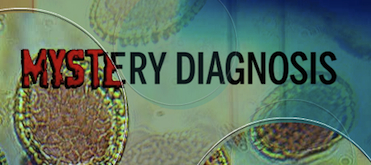One of my favorite guilty pleasures is the TV show “Mystery Diagnosis” on Discovery Health.
The true stories in the shows follow a pretty standard format. The patient starts out normally, but somewhere along the way, a weird symptom emerges, usually followed by more bizarre symptoms. Sometimes a seemingly irrelevant tidbit will be thrown in early on, and you can be pretty sure this information will turn out to be an important plot point, such as on a recent show when a mother stated that portrait photos of her two-year-old made the child appear that she had Down syndrome. It turned out, of course, that she did have a form of Down syndrome.
The shows have rather lurid titles, such as The Woman Who Couldn’t Cry, The Girl Who Couldn’t Be Touched, and The Girl Who Turned Blue. Invariably, the script includes a line: “Nothing could have prepared her for [what the doctor told her] or [the hideous new symptom that emerged.]”
But the real hook of the show is that no one can figure out what’s wrong with these patients, who see doctor after doctor sometimes for years before finally getting a diagnosis. Doctors keep telling these patients there’s nothing wrong with them.
Which brings me to a recent blog entry by Paul Furiga in which he describes taking an elderly aunt to the emergency room. He observed ER doctors overwhelmed by, even drowning in, data. They had to spend most of their time, Furiga writes “‘connecting the dots’ of informational components that included patient histories, diagnostic results, and physician phone consultations, vital sign reports and the like.”
Imagine if there were an easier way to take slews of data and connect the dots.
Ahhh, but there is: story.
Furiga calls for a medical “person who could share the patient’s ‘story’ in a way that connected all the dots and the bits and bytes of data so that a complete (and accurate) diagnosis could be made.” He asks: “Why does the model of treatment not place a trained professional front and center to continually provide patient context to physicians?”
Although narrative medicine has been making inroads, medical training generally omits patients stories. Mary Sykes Wylie writes in an article about child psychologist Daniel Siegel (about whom I will write more in the future) that in medical school (granted this was in 1978), Siegel was “regularly being dressed down for spending too much time listening to his patients’ stories. ‘If you want to listen to people’s stories, go to social work school-that’s not what doctors do!’ one irate supervisor told him.”
If doctors really listened to their patients’ stories instead of relying on mounds of data, perhaps there’d be no material for a “Mystery Diagnosis” show.
